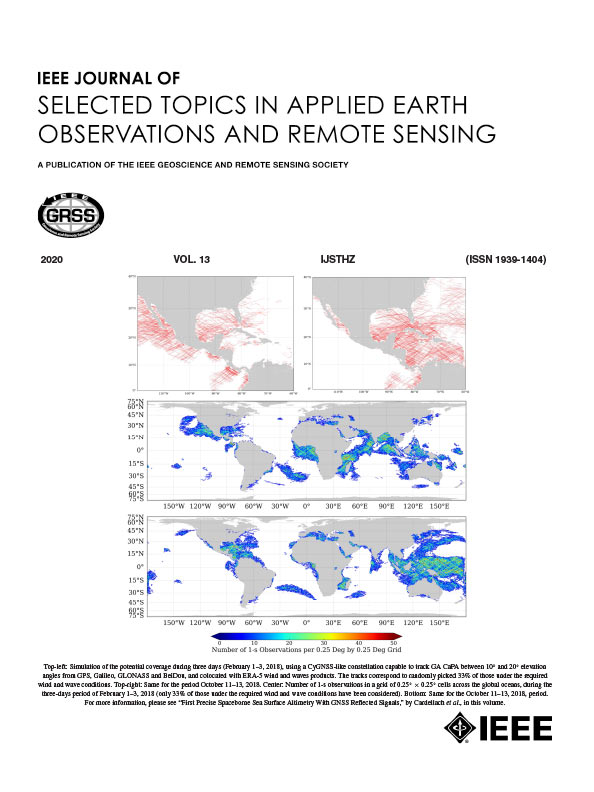分而治之:低光遥感图像增强的频域解耦策略
IF 5.3
2区 地球科学
Q1 ENGINEERING, ELECTRICAL & ELECTRONIC
IEEE Journal of Selected Topics in Applied Earth Observations and Remote Sensing
Pub Date : 2025-09-17
DOI:10.1109/JSTARS.2025.3611820
引用次数: 0
摘要
低光遥感(RS)图像通常覆盖广阔的区域。它们包含各种尺度的物体,并具有局部光源。这使得在保持良好图像结构的同时提高亮度具有挑战性。现有的方法主要是在空间领域设计的。然而,由于照明退化和结构信息之间的紧密耦合,这些方法往往难以实现有效的增强。在本文中,我们提出了一种分而治之的频域解耦增强策略。具体而言,通过探索频域的解耦特性,我们设计了一个轻对比正则化,该正则化约束模型只关注对比度空间中的亮度分布,同时减少冗余信息的干扰。此外,我们还引入了一种新的相位曼巴增强网络,它利用了频域独特的连续性。通过采用连续扫描机制,我们的模型有效地捕获了低光RS图像中的远程依赖关系,从而实现了更细粒度的结构恢复。大量的实验表明,我们的方法在质量和数量上都超过了最先进的方法。本文章由计算机程序翻译,如有差异,请以英文原文为准。
Divide-and-Conquer: Frequency-Domain Decoupling Strategy for Low-Light Remote Sensing Image Enhancement
Low-light remote sensing (RS) images typically cover vast areas. They contain objects of various scales and have localized light sources. This makes it challenging to enhance brightness while preserving fine image structures. Existing approaches are primarily designed in the spatial domain. However, due to the tight coupling between illumination degradation and structural information, these methods often struggle to achieve effective enhancement. In this article, we propose a divide-and-conquer frequency domain decoupling enhancement strategy. Specifically, by exploring the decoupling properties of the frequency domain, we design a light contrastive regularization that constrains the model to focus solely on brightness distribution in the contrastive space while reducing interference from redundant information. In addition, we introduce a novel phase mamba enhancement network, which leverages the unique continuity of the frequency domain. By employing a continuous scanning mechanism, our model effectively captures long-range dependencies in low-light RS images, enabling finer grained structural restoration. Extensive experiments demonstrate that our method surpasses state-of-the-art approaches both qualitatively and quantitatively.
求助全文
通过发布文献求助,成功后即可免费获取论文全文。
去求助
来源期刊
CiteScore
9.30
自引率
10.90%
发文量
563
审稿时长
4.7 months
期刊介绍:
The IEEE Journal of Selected Topics in Applied Earth Observations and Remote Sensing addresses the growing field of applications in Earth observations and remote sensing, and also provides a venue for the rapidly expanding special issues that are being sponsored by the IEEE Geosciences and Remote Sensing Society. The journal draws upon the experience of the highly successful “IEEE Transactions on Geoscience and Remote Sensing” and provide a complementary medium for the wide range of topics in applied earth observations. The ‘Applications’ areas encompasses the societal benefit areas of the Global Earth Observations Systems of Systems (GEOSS) program. Through deliberations over two years, ministers from 50 countries agreed to identify nine areas where Earth observation could positively impact the quality of life and health of their respective countries. Some of these are areas not traditionally addressed in the IEEE context. These include biodiversity, health and climate. Yet it is the skill sets of IEEE members, in areas such as observations, communications, computers, signal processing, standards and ocean engineering, that form the technical underpinnings of GEOSS. Thus, the Journal attracts a broad range of interests that serves both present members in new ways and expands the IEEE visibility into new areas.

 求助内容:
求助内容: 应助结果提醒方式:
应助结果提醒方式:


